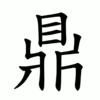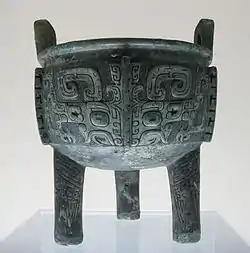鼎
| ||||||||
| ||||||||
Translingual
| Stroke order | |||
|---|---|---|---|
 | |||
Han character
鼎 (Kangxi radical 206, 鼎+0, 13 strokes in traditional Chinese and Japanese, 12 strokes in mainland China, cangjie input 月山女一中 (BUVML), four-corner 22221, composition ⿶𤕰目)
- Kangxi radical #206, ⿍.
Derived characters
Usage notes
- There is regional variation in the stroke order of the character:
- In mainland China, Japan and Hong Kong, the sixth stroke is 豎折折.
- In Taiwan, the sixth stroke is 豎折 and the seventh stroke is 豎.
- In Japan and Hong Kong, the twelfth stroke is 橫 and the thirteenth stroke is 豎.
- In mainland China, the twelfth stroke is 橫折, corresponding to the thirteenth stroke in Taiwan.
References
- KangXi: page 1525, character 8
- Dai Kanwa Jiten: character 48315
- Dae Jaweon: page 2060, character 20
- Hanyu Da Zidian (first edition): volume 7, page 4740, character 1
- Unihan data for U+9F0E
Chinese
| simp. and trad. |
鼎 | |
|---|---|---|
Glyph origin
| Historical forms of the character 鼎 | |||
|---|---|---|---|
| Shang | Western Zhou | Shuowen Jiezi (compiled in Han) | Liushutong (compiled in Ming) |
| Oracle bone script | Bronze inscriptions | Small seal script | Transcribed ancient scripts |
 |
 |
 |
 |
Characters in the same phonetic series (鼎) (Zhengzhang, 2003)
Pictogram (象形) .
Etymology
From Proto-Sino-Tibetan *(m/ʔ)-di(k/ŋ) (“pot; cauldron”) (STEDT).
Pronunciation
Definitions
鼎
- ding (ancient large, three-legged bronze cauldron for cooking or sacrificial rituals)
- (figurative) throne; monarchy
- (figurative, historical) important figures in the government
- (figurative) big; great
- (figurative) tripartite balance of forces
- (historical) ancient instrument of torture
- (literary) just (at this time); meanwhile
- (Min) wok
- 50th hexagram of the I Ching
- a surname
Synonyms
Dialectal synonyms of 鍋 (“wok; cooking pot”) [map]
Compounds
Derived terms from 鼎
|
|
Further reading
- “Entry #10387”, in 臺灣閩南語常用詞辭典 [Dictionary of Frequently-Used Taiwan Minnan] (in Chinese and Min Nan), Ministry of Education, R.O.C., 2011.
Japanese
Readings
- Go-on: ちょう (chō)←ちやう (tyau, historical)
- Kan-on: てい (tei)←てい (tei, historical)
- Kun: かなえ (kanae, 鼎)←かなへ (kanafe, 鼎, historical)
- Nanori: かなえ (kanae); かね (kane)
Compounds
Compounds
- 鼎座 (teiza, “a three-way seating arrangement with three people facing each other; to sit in such an arrangement”)
- 鼎足 (teisoku, “the legs of a tripod; a three-way opposition; a triumvirate in support of a superior”)
- 鼎峙 (teiji, “a three-way opposition; to stand in three-way opposition”)
- 鼎談 (teidan, “a three-way conversation; to have a three-way conversation”)
- 鼎部 (teibu, “that set of kanji that have the character 鼎 as the radical”)
- 鼎立 (teiritsu, “a three-way opposition; to stand in three-way opposition”)
Etymology 1
| Kanji in this term |
|---|
| 鼎 |
| かなえ Jinmeiyō |
| kun’yomi |
Originally a compound of 金 (kana, “metal”) + 瓮 (he, “a pot or pan for holding food or beverages”).[1][2]
Alternative forms
- 釜 (less common)
Noun
- a three-legged kettle, a tripod kettle, used for cooking and later for ceremonial purposes in ancient China, and often made of bronze
- a symbol of a king or other high authority
Idioms
- 鼎の軽重を問う (kanae no keijū o tō): "to ask about the weight of a kettle" ⇒ to question a person's ability
- 鼎の沸くが如し (kanae no waku ga gotoshi): "just like a boiling kettle" ⇒ a metaphor for a noisy busy situation
- 鼎の中の一切れの肉 (kanae no naka no hitokire no niku): "single slice of meat [from] in the kettle" ⇒ to get a read on the whole from a small sample
- 鼎を扛ぐ (kanae o agu): "to lift a kettle" ⇒ to be physically strong
- 鼎を定む (kanae o sadamu): "to settle the kettle" ⇒ to control the imperial capital, to ascend the throne
Etymology 2
| Kanji in this term |
|---|
| 鼎 |
| てい Jinmeiyō |
| on’yomi |
From Middle Chinese 鼎 (MC teŋX). Compare modern Mandarin 鼎 (dǐng).
Noun
鼎 • (tei)
References
- 1988, 国語大辞典(新装版) (Kokugo Dai Jiten, Revised Edition) (in Japanese), Tōkyō: Shogakukan
- 2006, 大辞林 (Daijirin), Third Edition (in Japanese), Tōkyō: Sanseidō, →ISBN
- 1997, 新明解国語辞典 (Shin Meikai Kokugo Jiten), Fifth Edition (in Japanese), Tōkyō: Sanseidō, →ISBN
Korean
Hanja
鼎 • (jeong) (hangeul 정, revised jeong, McCune–Reischauer chŏng, Yale ceng)
- This term needs a translation to English. Please help out and add a translation, then remove the text
{{rfdef}}.
Vietnamese
This article is issued from Wiktionary. The text is licensed under Creative Commons - Attribution - Sharealike. Additional terms may apply for the media files.
